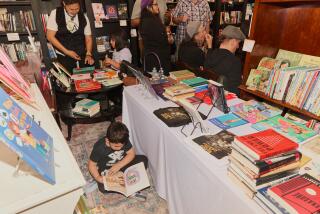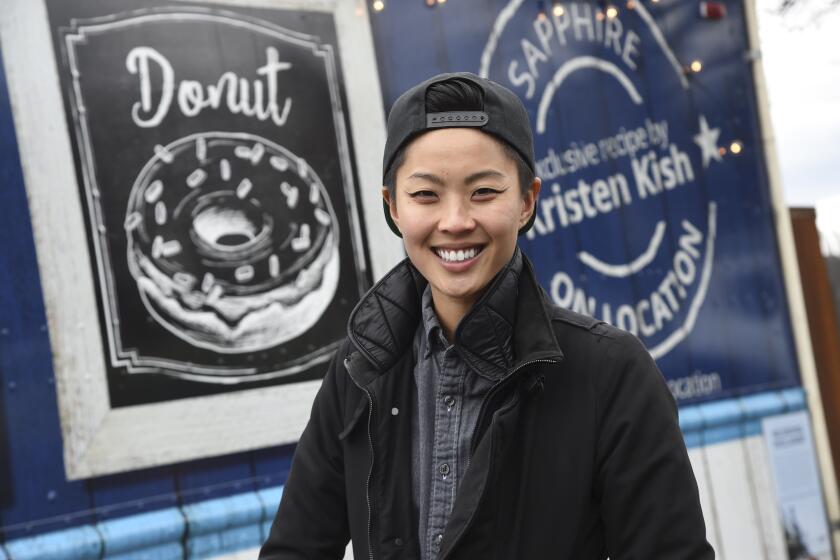The Books Kids Love to Do : Publishing: Braid it, juggle it or eat it: Three-dimensional books from Klutz Press come with the equipment children need to experience what they read.
- Share via
PALO ALTO — In the button-down world of book publishing, Klutz Press sits in a corner by itself.
A life-sized cardboard Einstein shares the children’s book company’s yellow- green- and blue-painted offices with a huge inflatable pig dangling from the ceiling.
The production manager has a doctorate in intellectual history and the warehouse supervisor has a law degree, but no one seems to have a suit. (When one was needed for a book illustration, it had to be borrowed from a friend of a friend of an employee.)
“We’re an odd duck,” admits Klutz co-founder and president John Cassidy, a rumpled and gangly man of 43 whose office is knee-deep in books, toys and rubber chickens.
He sums up his 16-year-old business this way: “Sometimes we’re a little off the beaten track. Other times we’re way off the beaten track.”
For all its oddity, Klutz with its 30 employees is a wildly successful multimillion-dollar publisher of interactive children’s books that cover everything from how to juggle (its first) to the art of making braids and bows. Cassidy’s company ships between 4 million and 5 million books to stores every year.
The brightly illustrated books, some of which spend months on children’s bestseller lists, sell for $5 to $20. The pages are of durable cardboard with spiral binding, but the real mark of a multi-sensory three-dimensional Klutz book is that it comes with the equipment children need to experience what they read.
“You do these books,” Cassidy says. “You are eating something or running somewhere.”
“Kids Shenanigans: Great Things to do that Mom and Dad will just Barely Approve Of” comes with a whoopie cushion kit. A paint set accompanies “Watercolor for the Artistically Undiscovered,” which is illustrated by best-selling children’s artist Thacher Hurd, whose advice reads, “Don’t think. Just paint.”
The “Explorabook,” published in collaboration with San Francisco’s Exploratorium science museum, contains such equipment as a magnet, mirror and packets of agar for bacterial cultures (“bacteria snack food” in Klutzspeak).
“Book publishers do their thing, toy companies do their thing and we are somewhere in between,” Cassidy says. “We’re kind of like light manufacturing. We’re a hybrid.”
The materials that come with the books are purchased all over the world. The paint set selected for “Watercolor” is manufactured in London, the bean bags for juggling in Korea. Since the beginning, the books and accouterments have been assembled at Hope Rehabilitation Services in Santa Clara, a facility that employs 600 developmentally disabled people.
“The company, more than most others, has a human quality about it,” says Hope president Jim Purcell, whose organization assembles 30,000 Klutz books each week. At the joint holiday party for Klutz and Hope workers, “Klutz donated the ice cream and John served it,” says Purcell.
“Klutz is kind of like this wacky West Coast company that a lot of the traditional publishing establishments do not consider a serious book publisher,” says Kurt Feichtmeir, general manager of consumer products at the Exploratorium. “That’s because Klutz doesn’t act like a serious publisher. It’s also envy; it does a huge amount of business.
“Klutz really pioneered the whole trend that is now very prevalent among other publishers: to have a book plus a gadget or gizmo or something attached to it,” he says. “But nobody does it as well as Klutz. Publishers who try to do this don’t know where to start. They know how to print on paper. Period.”
The Klutz special touch is also admired in the industry. “There are companies out there that are doing similar projects, but there probably isn’t anyone who can touch Klutz at this point,” says Shannon Maughan, associate editor of children’s books for the trade journal Publishers Weekly.
Cassidy calls Klutz a case of accidental success. In the late 1970s, a group of Stanford University liberal arts majors, including Cassidy and his wife, Nancy, had one goal: to support their avocation as river-raft guides in Northern California and Idaho with the least amount of effort.
Their first stab at making a fortune, offering juggling lessons for $1 on Stanford’s White Plaza, was a bust.
Then, in 1977, they came up with the book, “Juggling for the Complete Klutz.” The initial investment was a few thousand dollars.
The responses when they marketed their first printing of 3,000 indicated they were on to something unique. “Bean bags were attached to the book,” Cassidy says. “Bookstores said we should go to toy stores, and toy stores said we should go to bookstores.”
The book ended up in both, and “Juggling for the Complete Klutz” has sold more than 1 million copies.
They waited until 1982 to publish their second, “The Hacky Sack Book,” which also came with bean bags, this time for a kicking game. “We were skeptical about being capitalists,” Cassidy recalls. “Our noses had to be rubbed into it.
“For the first four or five years, we were running rivers more than anything else. We kept thinking Klutz would fizzle out. At one point we said, ‘Klutz seems to be dying out.’ Then we realized none of us had been to our post office box for two weeks.”
Cassidy says he didn’t take his business seriously until he became a parent in 1984. Now, Klutz has won children’s book awards including the Parents’ Choice Award for Doing and Learning, Bookbuilders West Award for design and the American Assn. of Museums award for design. Nancy Cassidy, a singer, has produced children’s tapes for Klutz, including “Kids’ Songs I,” which has sold more than half a million copies.
Cassidy tests potential products on his two sons, Cody, 8, and Scotty, 5, and the three daughters of one of his two partners, who now live outside California. Says Cassidy: “They’re our only market research.”
Nor does Klutz do any advertising other than displaying its books in stores. (Klutz books sold at Eddie Bauer stores have special Eddie Bauer covers. Because of a long business relationship between the two companies, “we did it as a favor to them,” says Dewitt Durham, head of purchasing at Klutz.)
Hurd, the “Watercolor” illustrator, attributes Klutz’s success to Cassidy’s willingness to take risks. “He has a lot of ideas, and he trusts his instincts. He’s not afraid to go in his own direction. So many New York publishers are looking over their shoulders: ‘What will librarians say about it? What will teachers say about it?’ ”
Hurd also likes Klutz’s policy of publishing large runs of only a few books per year, which keeps down the cost per copy. “Watercolor” sells for $18.95. “A Klutz-type book from another publisher would cost $30 or more,” Hurd says.
Klutz’s catalogue lists only 32 titles. The company relies on each book to be a big seller for many years.
“A typical publisher throws a lot of books out there every year; some are hits, and some are misses,” Cassidy says. “The next year you have a whole new thing to throw out there, and last year’s hits are history. Big New York publishers have thousands of books in print: That’s the way mosquitoes replicate. We’d never make it as a mosquito.”
Klutz books are sold in bookstores as well as in an eclectic array of other businesses, from clothing stores to sporting outlets. Customers also can order from “The Klutz Flying Apparatus Catalogue,” which offers the books and other kid stuff, including rubber rodents and vinyl vermin, stilts, propeller beanies and “dead legs”--anatomically correct rubber legs that can be placed to poke out of file cabinets, drawers or refrigerators.
Future catalogues may look a bit different. “Exploratorium,” which has sold 350,000-plus copies in 18 months--amazing for a children’s science book--was a turning point. Cassidy has decided to change Klutz’s goofball playground focus on knots, yo-yos, bubbles, marbles, jacks and “Icky-Poo” to do some more educational subjects.
Scott-Foresman, a division of HarperCollins, the nation’s largest publisher of science books for elementary age students, is including “Explorabook” in its curriculum package.
Klutz is preparing geography and math books for 1994.
“You can’t get any more un-fun than math,” says Cassidy, who consults with educators and experts for each project but primarily writes the books himself.
In the new geography book, Cassidy wants to illustrate life in a Third World country without words or photographs. One inclusion will be small packets of rice for kids to cook and eat.
“The activity will be to boil this up and skip lunch,” he says. “That’s a classic example of what we do with a Klutz book.”
Klutz is an “imagination factory,” according to Cassidy, who says he’s happy to remain a relatively small producer of creative children’s books. An aggressive growth strategy “would be weird.”
He has other pressing things to ponder. Office discussions have recently focused on whether the inflated pig overhead should be replaced with a giant stuffed gorilla. At Klutz, they think about these things. They really do.
“Cassidy enjoys the success of his company, but he’s not in it for his ego,” says Hurd. Which is perhaps why, when Klutz opens the booth that Hillary Clinton has invited the company to bring to her pre-inaugural “A Salute to Youth” at the Kennedy Center, Cassidy will be there--giving free juggling lessons.
More to Read
Sign up for our Book Club newsletter
Get the latest news, events and more from the Los Angeles Times Book Club, and help us get L.A. reading and talking.
You may occasionally receive promotional content from the Los Angeles Times.










